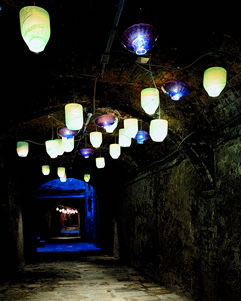 |
Tobias
Rehberger loves strong colors and objects taken from our daily life. His
approach to life is joyous and he is caught up in the desire to create an
accord between nature and man’s action. For the "Manifesta 2"
exhibition he invented a large horizontal painting made of flowers and plants,
in other words a garden with strong geometric divisions that showed how
one can paint with plants as well as brushes. In much the same way his "sculptures"
made of colored vases full of flowers have been exhibited in places devoted
to "fine" arts but they introduce those "applied" arts
that anyone can make at home. This union of human handicraft and nature,
not to mention of inside and outside elements, is also found at the foundation
of the work Rehberger presented at Colle di Val d’Elsa.
|
|
| |
 The
artist chose to work in an old covered passageway, a kind of tunnel onto
which private homes and storage spaces open their doors. Here he installed
about one hundred and fifty glass lamps (a product typically produced in
this town), each one hand-blown and colored with different pigments at one
of the last workshops in Colle that is still able to do this kind of job.
Rehberger attached the lamps to the passageway ceiling, dividing them by
type (white cylinders, red spheres, double purple cones…) as if they
were crowded bunches or species. Then he created a link between two of the
earth’s geographic poles which are situated at opposite sides of a
diameter: places in the world where the rhythms of the day in one place
correspond to those of the night in the other. Montevideo, the city Rehberger
chose to relate to Colle di Val d’Elsa, is situated in the southern
hemisphere. Thanks to an Internet link, the lights in the Tuscan passageway
turn on when it starts to get dark in Montevideo, that is when the inhabitants
of Montevideo’s homes turn on their lights. So it is almost as if their
artificial lighting crossed the earth, rising on the opposite side. Meantime
objects typically found in indoor furnishings were displayed outdoors in
one of the central and historical streets of the Italian town. The
artist chose to work in an old covered passageway, a kind of tunnel onto
which private homes and storage spaces open their doors. Here he installed
about one hundred and fifty glass lamps (a product typically produced in
this town), each one hand-blown and colored with different pigments at one
of the last workshops in Colle that is still able to do this kind of job.
Rehberger attached the lamps to the passageway ceiling, dividing them by
type (white cylinders, red spheres, double purple cones…) as if they
were crowded bunches or species. Then he created a link between two of the
earth’s geographic poles which are situated at opposite sides of a
diameter: places in the world where the rhythms of the day in one place
correspond to those of the night in the other. Montevideo, the city Rehberger
chose to relate to Colle di Val d’Elsa, is situated in the southern
hemisphere. Thanks to an Internet link, the lights in the Tuscan passageway
turn on when it starts to get dark in Montevideo, that is when the inhabitants
of Montevideo’s homes turn on their lights. So it is almost as if their
artificial lighting crossed the earth, rising on the opposite side. Meantime
objects typically found in indoor furnishings were displayed outdoors in
one of the central and historical streets of the Italian town.
The installation’s appearance is spectacular and welcomes the visitor
with a feast of emotions. But behind this open and playful aspect one can
make out a less immediate reading. For decades the cultural debate has tended
to privilege what is international with respect to what is local. The development
of Internet but also of a new awareness of the importance of cultural regions
has led us to see globalization today no longer as an erasure of places’
specific characteristics but rather as a way of exalting them all. Rehberger’s
work deliberately inspires wonder in order to remind us of our ability to
marvel at what is simple but at the same time complex, the result of a union
between local manual traditions and technological know-how. |
|
| |
|
|

